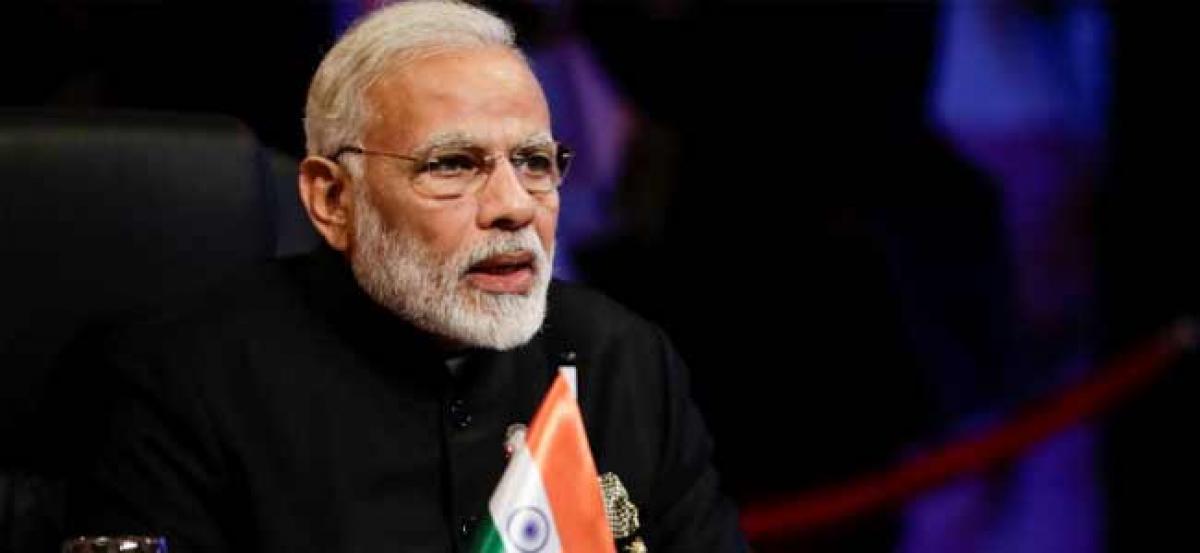Live
- NASA Tracks Five Giant Asteroids on Close Approach to Earth Today
- Pushpa 2 Hits ₹1000 Crore in 6 Days: How It Compares to Other Top Indian Films
- Vivo X200 and X200 Pro Launched in India: Price, Specifications, and Features
- Nitin Gadkari Admits Feeling Embarrassed at Global Summits Over Rising Road Accidents in India
- Comprehensive Review on Indiramma Housing Survey and Welfare Initiatives Conducted via Video Conference
- Jogulamba Temple Records Rs 1.06 Crore Hundi Revenue in 150 Days
- Opposition Slams ‘One Nation, One Election’ Bill as Anti-Democratic; BJP Allies Support the Move
- Celebrate Karthigai Maha Deepam Virtually with Sri Mandir’s LIVE Darshan Experience
- BJP Extends Support to Samagra Shiksha Abhiyan Employees' Strike, Demands Immediate Regularization and Welfare Benefits
- Dr. M. Priyanka Stresses Quality Education, Nutritious Meals, and Cleanliness in Schools
Just In

Moody’s Investors Service upgraded its ratings on India’s sovereign bonds for the first time in nearly 14 years on Friday, saying continued progress on economic and institutional reform will boost the country’s growth potential.
MUMBAI/BENGALURU: Moody’s Investors Service upgraded its ratings on India’s sovereign bonds for the first time in nearly 14 years on Friday, saying continued progress on economic and institutional reform will boost the country’s growth potential.
The agency said it was lifting India’s rating to Baa2 from Baa3 and changed its rating outlook to stable from positive as risks to India’s credit profile were broadly balanced.
Moody’s upgrade, its first since January 2004, moves India’s rating to the second lowest level of investment grade. Standard & Poor’s has kept India at the lowest investment grade just above junk status for a decade and Fitch Ratings for one year longer.
The decision by Moody’s is a shot in the arm for Prime Minister Narendra Modi’s government and the reforms it has pushed through, and comes just weeks after the World Bank moved India up 30 places in its annual ease of doing business rankings.
All Indian markets including stocks, bonds and rupee rallied on the ratings upgrade.
“It seems like Santa Claus has already opened his bag of goodies,” said Lakshmi Iyer, head of fixed income at Kotak Mutual Fund said.
“The move is overall positive for bonds which were caught in a negative spiral. This is a structural positive which would lead to easing in yields across tenors,” she said.
Last year, India lobbied hard with Moody’s for an upgrade, but failed. The agency raised doubts about the country’s debt levels and fragile banks, and declined to budge despite the government’s criticism of its rating methodology.
Finance Minister Arun Jaitley told reporters Moody’s decision was a “belated recognition” of the steps the government has taken to fix India’s $2 trillion economy.
Modi’s top colleagues portrayed it as a further victory for the prime minister after U.S.-based research agency Pew released a survey this week that showed nearly nine out of 10 Indians held a favorable opinion of him.
OTHER UPGRADES DOUBTED
But some economists said an upgrade from the other big rating agencies soon seemed unlikely.
Radhika Rao, an economist at DBS, said implementation of reforms, a subdued rural sector and weak investment have slowed economic growth while rising oil prices have raised the risks.
“We don’t think the other two global rating agencies – Fitch and S&P - will follow-up in a hurry, based on their cautious rhetoric,” she said, noting their concerns on “weak” state and central government finances.
Jaitley said the government will stick to the path of fiscal consolidation. It has targeted keeping the fiscal deficit to 3.2 percent of gross domestic product for the year ending in March 2018 and to reach 3 percent in 2018/19.
“We will maintain the fiscal discipline,” he said, expressing confidence existing policies will let India “glide” to a stronger financial position.
Moody’s separately raised the ratings of top Indian lender State Bank of India , HDFC Bank as well as state-run energy firms, NTPC, NHPC , GAIL India Limited and the National Highways Authority of India, potentially lowering their borrowing costs.
MARKETS SURGE
At 0800 GMT, the benchmark 10-year bond yield was down 9 basis points at 6.97 percent, the rupee was trading stronger at 64.91 per dollar versus the previous close of 65.3250, while the NSE share index was 1 percent higher.
But debt traders said the rally was unlikely to last beyond a few days, as the coming heavy bond supply and hawkish inflation outlook were unlikely to change soon.
“Who has the guts to continue buying in this market?” said a bond trader at a private bank. [L1N1NN06A]
Moody’s said the recently-introduced goods and services tax (GST), a landmark reform that turned India’s 29 states into a single customs union for the first time, will boost productivity by removing barriers to inter-state trade.
“In the meantime, while India’s high debt burden remains a constraint on the country’s credit profile, Moody’s believes that the reforms put in place have reduced the risk of a sharp increase in debt, even in potential downside scenarios,” the ratings agency said.
Still, some market participants questioned the timing of the move.
“The timing is little dicey for the upgrade given that there are lot of concerns over the government’s fiscal discipline,” said a foreign bank dealer.
Moody’s said it expects India’s real GDP growth to moderate to 6.7 percent in the fiscal year ending in March 2018 from 7.1 percent a year earlier.
The agency also raised India’s local currency senior unsecured debt rating to Baa2 from Baa3 and its short-term local currency rating to P-2 from P-3.
Moody’s noted that while a number of key reforms remain at the design phase, it believes those already implemented will advance the government’s objective of improving the business climate, enhancing productivity and stimulating investment.
“Longer term, India’s growth potential is significantly higher than most other Baa-rated sovereigns,” said Moody‘s.

© 2024 Hyderabad Media House Limited/The Hans India. All rights reserved. Powered by hocalwire.com







